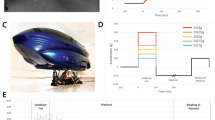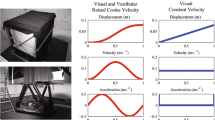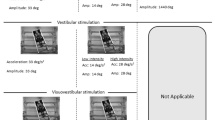Abstract
We studied the gain of smooth ocular tracking for visual, vestibular and arthrokinetic cues, in combination as well as separately, in order to examine how these multisensory cues influence tracking performance. By use of motion along a linear track (besides the self-evident visual influence) evidence was found for arthrokinetic and vestibular enhancement of smooth ocular tracking. These results were in close correspondence with the results of our former study about arthrokinetic influence on linear self-motion perception. Therefore, we conclude that information from the limbs about linear (self-)movement has analogous characteristics and generates analogous responses to the information about angular (self-)movement.
Similar content being viewed by others
References
Berthoz A, Israël I, Viéville T, Zee D (1987) Linear head displacement measured by the otoliths can be reproduced through the saccadic system. Neurosci Lett 82:285–290
Bles W (1981) Stepping around: circular vection and coriolis effects. In: Long J, Baddely A (eds) Attention and performance IX. Erlbaum, Hillsdale, N.Y. pp 47–61
Bles W, Klören T, Büchele W, Brandt T (1983) Somatosensory nystagmus: physiological and clinical aspects. Adv Ottolaryngol 30:30–33
Bles W, Jelmorini M, Bekkering H, de Graaf B (1994) Vestibular Res (In press)
Bles W, Jelmorini M, Bekkering H, de Graaf B (1994) Arthrolimetic information affects linear self-motion perception. J Vestib Res (in press)
Brandt T, Büchele W (1977) Arthrokinetischer nystagmus bei passiven arm und beinbewegungen. In: Kommerell G (ed) Augenbewegungsstörungen. Neurophysiologie und klinik. Bergmann, Munich, pp 285–289
Buizza A, Schmid R, Droulez J (1981) Influence of linear acceleration on oculomotor control. In: Füchs, Becker (eds) Progress in oculomotor research. Elsevier/North-Holland, Amsterdam, pp 517–524
Dichgans J, Brandt W (1978) Visual-vestibular interaction: effects on self-motion perception and postural control. In: Held R, Leibowitz HW, Teuber HL (eds) Handbook of sensory physiology, vol VIII. Springer, Berlin Heidelberg New York
Gauthier GM, Hofferer JM (1976) Eye tracking of self-moved targets in the absence of vision. Exp Brain Res 26:121–139
Glenny G, Heywood S (1979) Hans Gertz revisited. The different effects of invisibility and darkness on eye movements. Perception 8:31–36
Graaf B de, Wertheim AH, Bles W, Kremers J (1990) Angular velocity, not temporal frequency, determines circular vection. Vision Res 30:637–646
Jordan S (1970) Ocular pursuit movement as a function of visual and proprioceptive stimulation. Vision Res 10:775–780
Mather JA, Lackner JR (1980a) Multiple sensory cues enhance the accuracy of pursuit eye movements. Aviat Space Environ Med 51:586–589
Mather JA, Lackner JR (1980b) Visual tracking of active and passive movements of the hand. Q J Exp Psychol 32:307–316
Mather JA, Lackner JR (1981) The influence of efferent proprioceptive, and timing factors on the accuracy of eye-hand tracking. Exp Brain Res 43:406–412
Reulen JPH, Marcus JT, Koops D, Vries de FR, Tiesinga G, Boshuizen K, Bos JE (1988) Precise recording of eye movement: the IRIS technique, Part 1. Med Biol Eng Comput 26:20–26
Shelhamer M, Young LR (1991) Linear acceleration and horizontal eye movements in man. Acta Otolaryngol [Suppl] 481:277–281
Skipper JJ, Barnes GR (1989) Eye movements induced by linear acceleration are modified by visualisation of imaginary targets. Acta Otolaryngol (Stockh) [Suppl] 468:289–293
Steinbach MJ (1969) Eye tracking of self moved targets: the role of efference. J Exp Psychol 82:366–376
Steinbach MJ (1976) Pursuing the perceptual rather than the retinal stimulus. Vision Res 16:1371–1376
Author information
Authors and Affiliations
Rights and permissions
About this article
Cite this article
de Graaf, B., Bos, J.E., Wich, S. et al. Arthrokinetic and vestibular information enhance smooth ocular tracking during linear (self-)motion. Exp Brain Res 101, 147–152 (1994). https://doi.org/10.1007/BF00243224
Received:
Accepted:
Issue Date:
DOI: https://doi.org/10.1007/BF00243224




